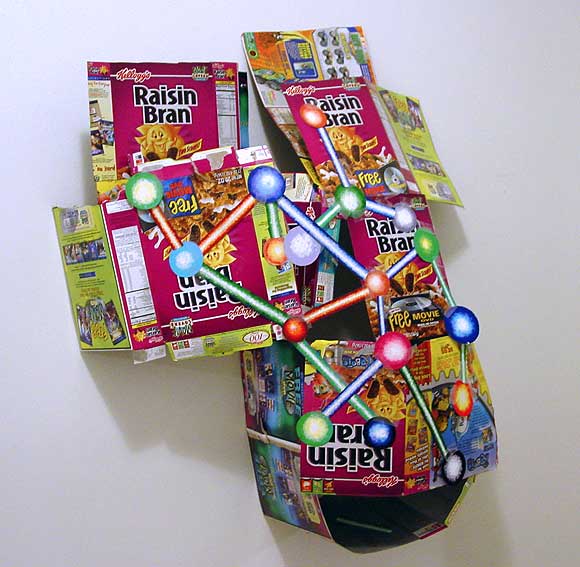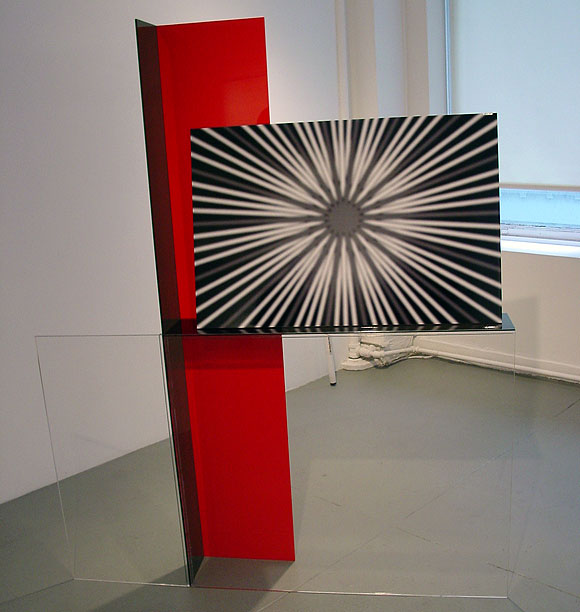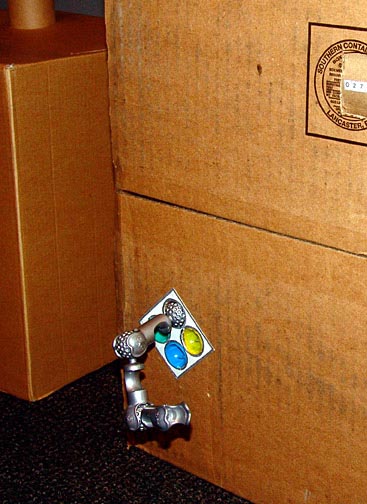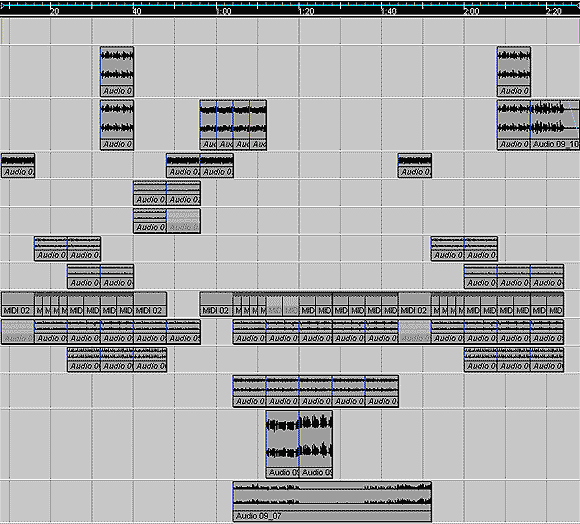View current page
...more recent posts
"I Hate The Others" [mp3 removed]
An attempt to reclaim drum and bass for all that is nerdy (with anthemic prog chorus, robotic reggae under-rhythm and a cowbell). My aim is the musical equivalent of the sculpture in the previous post.
Related: Neurofunk.
Related: Lost thread.
Update: I decided the anthemic prog chorus was bugging me, so I changed the piece to:
"I Hate The Others (Ethereal Version)" [mp3 removed]

Raisin Bran Molecule Sculpture, 2006, product packaging, ink jet print on cut paper, tape, staples, pushpins, 42 x 30 x 14 inches
series
Attack of the clones, part 2
This item just appeared in Artnet News; apparently "anonymous" shows are happenin':
"ANONYMOUS" ART SHOW IN FRANKFURT The Schirn Kunsthalle in Frankfurt is set to roll out "Anonymous: In the Future No One Will Be Famous," Oct. 31, 2006-Jan. 14, 2007. Organized by an anonymous curator and featuring a selection of anonymous artists (they have agreed not to reveal their identities for the duration of the show), the exhibition is a reaction to what participants describe as the pernicious branding of artists in the contemporary art world.Harlem's Triple Candie gallery also did an "anonymous" series in 2004 and 2005, consisting of two shows by artists whose identities won't be revealed (ever, according to co-gallerist Peter Nesbett.) The curatorial intent was essentially the same--"reaction to pernicious branding of artists in the contemporary art world"--although Triple Candie framed it more thoughtfully as an issue of "how biography informs interpretation." The shows weren't obscure: one was reviewed by Ken Johnson in the New York Times and the gallerists mentioned them in an interview they gave in Flash Art interview in this summer.
The artists have even published "Notes toward a Manifesto" (of anonymity, presumably), declaring, that "Anonymous artists wish to wriggle the status quo into a status incognitus. Their aim is to remove the increasing barbarization of thought via short circuits and fast lanes created by the marketing of artists as brands whose works have become masterpieces in ignorance of philosophy." Also available is a 160-page catalogue, edited by "anonymous" and Max Hollein -- as well as a limited-edition run of 500 catalogues with pages that are completely blank.
While it appears the Schirn Kunsthalle either doesn't read the art press or is, um, appropriating another gallery's recently-promoted concept, the affront may not be all that severe. The fact that the Kunsthalle's artists will be revealed at the end of the show makes it more of a coy guessing game, or publicity stunt, than any kind of transgressive curatorial effort.
Attack of the clones, part 1
Update: from curating.info (the exact link is bloggered): "dear tom moody, see the catalog to the exhibition, page 19. in an interview, the anonymous curator cites this Triple Candie exhibition as being one of the many predecesors of this anonymous show. [...]" -- tom about Curated by "Anonymous" Sat, 11.11.2006 16:35
Recommended: this music video titled "domain" [YouTube] by Guthrie Lonergan. On one level it's documenting people's dumb pictures of their workstations and home entertainment centers posted to the web, a veritable consumer orgy of "stuff we need to be happy." But the slide show of nerd nooks keeps being interrupted by a mysterious geometric map flying across a computer-generated ocean, while sad, eerie strings play on the soundtrack. What is this "virtual ocean"? Is it where the gamers meet? The afterlife? And where are all the gamers? None of these photos have people in them, just gear. Are they dead? The camera following the map is perpetually approaching some signpost in the middle of the ocean. Is that it--the answer? Abrupt cut to black.

Art by Roy Stanfield, from a group show he organized at Moti Hasson gallery. The image is a copyright-free starburst pattern he scanned, fuzzed out in an imaging program, mounted on Plex, and perched on a ledge in this plexiglas structure. (The unfuzzed version is on the back.) Stanfield belongs to the proud tradition of what might be called "focused desultoriness" that includes Robert Rauschenberg and Rachel Harrison (but not so much Cady Noland, contrary to some earlier speculation--the work isn't as dark). His twist on those artists is the knowing and unpretentious use of digital technology and the Web in his content.
In August I did a post about the interesting cross-disciplinary issues that come up when critical-minded folks from the club music scene describe academic electronic music with their own carefully honed vocabularies and sensibilities. Another good example comes, of course, from electronic dance/post-punk specialist Simon Reynolds, in this respectfully irreverent paragraph I just found on his blog:
Along with its relative affordability, one of the things I like about the second-division electronic avant-classical is its generic-ness. I mean that most sincerely folks. There's two facets to this 1/ if it’s a genre you love (say, ardkore, or freakbeat/garage punk, or dub, or whatever) then the genre-icity is no problemo, in fact the more fiercely it is itself, rather than dabbling outside its own parameters, than the better really; plus you have such an appetite for the stuff in question that you crave the second or even third-division material. But also 2/ there's this extra element of pathos and even a tiny hint of comedy too. See, here’s these guys who thought they were opening up infinite vistas and spectra of sound, boldly going where no composer's gone, building the future, etc. Yet a lot of it does tend to sound a bit samey. Partly because they only had a few different instruments at this point to grapple with: the Buchla, the Moog, a few other machines. But also beca[us]e a certain lexicon of sounds and FX got established that people tended to go for. In fact if I have some time at some point I’d like to do a taxonomy of those 12 or 16 or 23 noises/devices/effects, 'cos they do tend to crop up rather frequently. The other reason the avant-electronic stuff can sound generic is that the composers tended to use the machines as tools for extending their pre-electronic ideas, rather than search for the absolute idiomatic thing the machine could do. So there’s a lot of post-serialist approaches being transposed to synthesiser, I reckon. Which is why you get that feeling of clutter and twitter, flurries of note-runs and clusters, a fidgety fraugh[t]ness. There's also that atmosphere of disquiet that's very post-War existen[t]ialist-modernist-neurotic, kinda highly-strung and almost hands-wringingly anguished at times. But I suppose this makes perfect sense, was inevitable: composers who studied theory and went through conservatory training and all that, who have followed the grand narrative of western musical thought all the way through to the present juncture, or their own personal version of that arc/dialectic/whatever--they're not going to suddenly junk all their ideas and concepts and nous and technique, and just lay themselves open to the potentialities of the machinery, in a state of mind-voided open-ness and zero preconceptions. They’re going to dictate to the technology rather than the other way round. But that explains why a lot of the avant-electronic music sounds like 20th Century classical, as opposed to utterly alien and foreign, which you get more with your rock people perhaps, who lack the composerly grounding and also have more of a cheap thrills/gimmicky slanted approach to new tech.

Kristin Lucas, Happy and Sad Sack Lunch Series 2005. (Detail above.)
More from her archive.
"Sawtooth Junction" [mp3 removed]
This is kind of a happy song, incorporating folk, classical, and techno-rave influences into a single perky package. Within my tiny little corner of the home-producer sphere, I do have ambitions. I'm starting to get a method down of playing* and recording blocks of notes, using those blocks to write harmonically and timbrally compatible new blocks, then shuffling everything around with an eye to song development or at least some unfolding surprises. Each recorded block is a gestalt or hybrid of a particular type of (synthesized, filtered) sound with a particular sequence of notes. A block could be a melody or a rhythm. Obviously the design of the sequencer/recorder shapes and encourages this composition method, just as I'm sure a harpsichord and musical staff paper bred its own type of music. I know others put a lot of effort into making "natural"-sounding transitions between measures but I Iike a certain music box artificiality in the sound.
*By playing I mean writing notes, programming the synths and filters, and letting the sequencer play the sounds. I'm into "post-hand" music in a way I'm not with art, entirely, yet.
Updated with minor edits: reduced the volume on one of the hi-hat tracks; fixed a couple of glitches.

